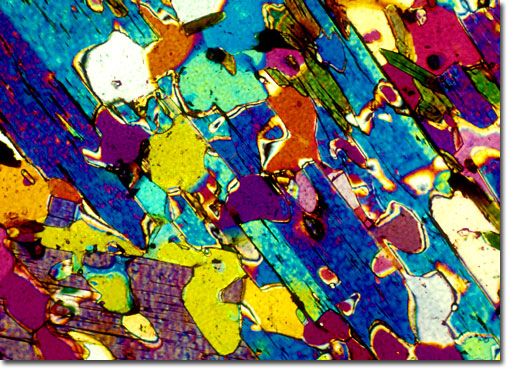Opal
|
A popular gem for many centuries, the fiery, brilliant opal is considered a mineraloid because, unlike other mineral gems, it does not have a truly crystalline structure. Nonetheless, opal does possess a highly complex structure. Random chains composed of silicon and oxygen are packed into tiny spheres, which are irregular in size, concentration, and arrangement in most opals. Only opals with a perfectly aligned grid of silica spheres will exhibit a characteristic play of color, which results from the diffraction of light passing through the gem. The size of the spheres determines the wavelengths diffracted and, therefore, the colors seen by an observer. The brilliance of diffracted colors is determined by the regularity of the grid. Opal is also one of the few gemstones that is sedimentary in origin. Millions of years ago, sandy sediments along the shorelines of ancient seas released silica into a solution that filled cracks in rocks, layers in clay, and even some fossils. As the silica solidified, some of it was transformed into opal, which still contains 6 to 10 percent water, a remnant of that ancient sea. Ancient opal was mined near in Hungary (now Eastern Slovakia) in the Old World and by the Aztecs in South and Central America. Today the finest opals are found primarily in Australia, Wales, and Mexico. The Romans highly valued opal, and the Roman historian Pliny described its beauty as the combination of the beauty of all other gems. Opal was also treasured during the Middle Ages and was called ophthalmios, or eye stone, because of the belief that it was beneficial to eyesight. Blonde women wore opal necklaces to protect their hair from losing its color. Queen Victoria loved opals and gave them quite often as wedding presents. She and her daughters popularized the stone as a fashion accessory, particularly after the discovery of an exciting new source of opals within the British Empire -- Australia. Gem scholars agree that the tradition of birthstones arose from the Breastplate of Aaron described in the Bible (Exodus 28, 15-30). The breastplate was a ceremonial religious garment set with twelve gemstones that represented the twelve tribes of Israel and corresponded with the twelve signs of the zodiac and the twelve months of the year. There are many different birthstone lists, however, and some argue that they should be assigned by astrological sign and not month. Opal is the birthstone for October and the zodiac sign Libra. |
© 1995-2025 by Michael W. Davidson and The Florida State University. All Rights Reserved. No images, graphics, software, scripts, or applets may be reproduced or used in any manner without permission from the copyright holders. Use of this website means you agree to all of the Legal Terms and Conditions set forth by the owners.
This website is maintained by our
|
